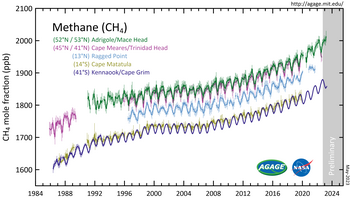
Back Metano atmosferico AN الميثان في الغلاف الجوي للأرض Arabic Metà atmosfèric Catalan Ατμοσφαιρικό μεθάνιο Greek Metano atmosférico Spanish متان موجود در جو Persian Méthane atmosphérique French Metano atmosférico Galician Агаар мандлын метан Mongolian Atmosferisch methaan Dutch

Atmospheric methane is the methane present in Earth's atmosphere.[1] The concentration of atmospheric methane is increasing due to methane emissions, and is causing climate change.[2][3] Methane is one of the most potent greenhouse gases.[4]: 82 Methane's radiative forcing (RF) of climate is direct,[5]: 2 and it is the second largest contributor to human-caused climate forcing in the historical period.[5]: 2 Methane is a major source of water vapour in the stratosphere through oxidation;[6] and water vapour adds about 15% to methane's radiative forcing effect.[7] The global warming potential (GWP) for methane is about 84 in terms of its impact over a 20-year timeframe, and 28 in terms of its impact over a 100-year timeframe.[8][9]
Since the beginning of the Industrial Revolution (around 1750) the methane concentration in the atmosphere has increased by about 160%, and this increase is almost entirely caused by human activities.[10] Since 1750 methane has contributed 3% of greenhouse gas (GHG) emissions in terms of mass[11] but is responsible for approximately 23% of radiative or climate forcing.[12][13][14] By 2019, global methane concentrations had risen from 722 parts per billion (ppb) in pre-industrial times to 1866 ppb.[15] This is an increase by a factor of 2.6 and the highest value in at least 800,000 years.[16]: 4 [17][18]
Methane increases the amount of ozone (O3) in the troposphere (4 miles (6 km) to 12 miles (19 km) from the Earth's surface) and also in the stratosphere (from the troposphere to 31 miles (50 km) above the Earth's surface).[19] Both water vapour and ozone are GHGs, which in turn add to climate warming.[5]: 2
- ^ Dlugokencky, Ed (December 5, 2016). "Trends in Atmospheric Methane". Global Greenhouse Gas Reference Network. NOAA Earth System Research Laboratory. Retrieved December 22, 2016.
- ^ Methane Tracker 2021. IEA (Report). Paris. 2021. Retrieved March 21, 2023.License: CC BY 4.0
- ^ "Methane in the atmosphere is surging, and that's got scientists worried". Los Angeles Times. March 1, 2019. Retrieved March 1, 2019.
- ^ "IPCC AR4 SYR Appendix Glossary" (PDF). 2007. Archived from the original (PDF) on November 17, 2018. Retrieved December 14, 2008.
- ^ a b c Cite error: The named reference
Collins_2018was invoked but never defined (see the help page). - ^ Cite error: The named reference
Stefan_2017was invoked but never defined (see the help page). - ^ Myhre, Gunnar; et al. (January 9, 2007). "Radiative forcing due to stratospheric water vapour from CH4 oxidation". Geophysical Research Letters. 34 (1). Bibcode:2007GeoRL..34.1807M. doi:10.1029/2006GL027472. S2CID 59133913.
- ^ "Methane: The other important greenhouse gas". Environmental Defence Fund.
- ^ Myhre, Gunnar; et al. (2013). Stocker, T.F.; Qin, D.; Plattner, G.-K.; Tignor, M.; Allen, S.K.; Boschung, J.; Nauels, A.; Xia, Y.; Bex, V.; Midgley, P.M. (eds.). Anthropogenic and Natural Radiative Forcing (PDF). Cambridge, United Kingdom and New York, USA: Cambridge University Press. Retrieved December 22, 2016.
{{cite book}}:|work=ignored (help) See Table 8.7. - ^ Cite error: The named reference
UNEP_2022was invoked but never defined (see the help page). - ^ Saunois, M.; Bousquet, M.; Poulter, B.; et al. (December 12, 2016). "The Global Methane Budget 2000–2012". Earth System Science Data. 8 (2): 697–751. Bibcode:2016ESSD....8..697S. doi:10.5194/essd-8-697-2016. hdl:1721.1/108811. ISSN 1866-3508. Retrieved August 28, 2020.
- ^ Cite error: The named reference
Etminan_Myhre_2016was invoked but never defined (see the help page). - ^ "Climate Change 2021. The Physical Science Basis. Summary for Policymakers. Working Group I contribution to the WGI Sixth Assessment Report of the Intergovernmental Panel on Climate Change". IPCC. The Intergovernmental Panel on Climate Change. Archived from the original on August 22, 2021. Retrieved August 22, 2021.
- ^ Ritchie, Hannah; Roser, Max; Rosado, Pablo (May 11, 2020). "CO₂ and Greenhouse Gas Emissions". Our World in Data. Retrieved March 19, 2023.
- ^ Cite error: The named reference
ESRL_trend_annualwas invoked but never defined (see the help page). - ^ Synthesis Report of the IPCC Sixth Assessment Report (AR6) (PDF) (Report). Summary for Policy Makers. March 19, 2023. p. 36. Archived from the original (PDF) on March 20, 2023. Retrieved March 20, 2023.
- ^ IPCC AR5 WG1 (2013). "Climate Change 2013: The Physical Science Basis – Summary for Policymakers" (PDF). Cambridge University Press.
{{cite web}}: CS1 maint: numeric names: authors list (link) - ^ Mann, Michael E. (ed.). "Radiative forcing". Encyclopædia Britannica. Retrieved March 19, 2023.
- ^ Wuebbles, Donald J.; Tamaresis, John S. (1993). "The Role of Methane in the Global Environment". In Khalil, M. A. K. (ed.). Atmospheric Methane: Sources, Sinks, and Role in Global Change. NATO ASI Series. Berlin, Heidelberg: Springer. pp. 469–513. doi:10.1007/978-3-642-84605-2_20. ISBN 978-3-642-84605-2.
© MMXXIII Rich X Search. We shall prevail. All rights reserved. Rich X Search